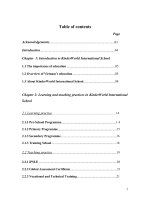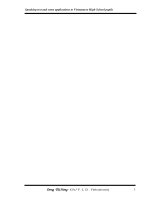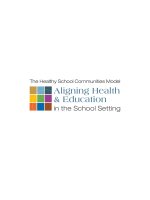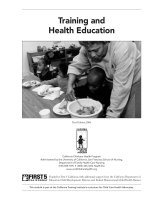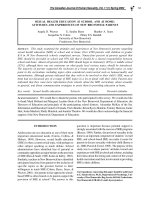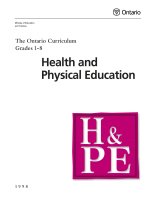Healthy and Balanced Living Curriculum Framework - Comprehensive School Health Education Comprehensive Physical Education pptx
Bạn đang xem bản rút gọn của tài liệu. Xem và tải ngay bản đầy đủ của tài liệu tại đây (1.13 MB, 32 trang )
Healthy and Balanced Living
Curriculum Framework
Comprehensive School Health Education
Comprehensive Physical Education
2006
2006
Connecticut State
Department of Education
George A. Coleman
Interim Commissioner of Education
Division of Teaching and Learning Programs and Services
George P. Dowaliby
Interim Associate Commissioner
Bureau of Health and Nutrition Services and
Child/Family/School Partnerships
Charlene Russell-Tucker
Bureau Chief
Coordinated School Health Partnership Staff
Cheryl Ann Resha
Bonnie Edmondson, Project Manager
Susan Fiore
Jo Ann Freiberg
Jean Mee, Project Manager
Scott Newgass
Offi ce of Communications
Deborah Koval
DTLPS Publications and Web Content Coordinator
Matthew Falconer
Editor
1
Healthy and Balanced Living
Curriculum Framework
Comprehensive School Health Education
Comprehensive Physical Education
2006
2
Acknowledgments
Numerous professionals contributed to the development of the Healthy and Balanced Living Curriculum
Framework. It was through their leadership, hard work, dedication and persistence that this document has be-
come a dynamic resource to address and promote the health and wellness of students in Connecticut.
A special thank you to the following individuals who served as the core writing team for the Healthy and Bal-
anced Living Curriculum Framework:
Patricia F. Miller, consultant and facilitator of committee;
Joe Amenta, Area Cooperative Educational Services;
Rosemarie Bonner, West Hartford Public Schools;
Cindy Garrey, Granby Public Schools;
Shirley Hughes, Ridgefield Public Schools;
John Novakowski, Bristol Public Schools;
Patty Pursell, Wallingford Public Schools;
Amanda Reed, early childhood consultant;
Kristen Trezza, New England Dairy & Food Council;
Heidi Zacchera, Canton Public Schools;
Charlene Russell-Tucker, State Department of Education;
Barb Westwater, State Department of Education; and
Joyce Staples, State Department of Education.
We would also like to thank Matt Falconer and Deb Koval for their editing and formatting of the document.
Bonnie J. Edmondson
Comprehensive School Health Education Consultant, HIV/STD Prevention Coordinator
Jean Mee
Comprehensive Physical Education and School Health Education Consultant
3
Healthy and Balanced Living Curriculum Framework
The Healthy and Balanced Liv-
ing Curriculum Framework
provides a blueprint for how
students can live an active and
healthy life. The goal of the
Framework is to show the link-
ages between the components
of comprehensive school health
education and comprehensive
physical education that lead to
a healthy and balanced life.
The Framework supports stu-
dents in making connections
and applying skills for a life-
time of health and well-being.
Four overarching curricular
outcomes equip students to live
actively and fully in a state of
personal, interpersonal and
environmental well-being:
skills, literacy, concepts and
plans, and advocacy.
Schools serve children from the
Pre-kindergarten level through
Grade 12, which represents a
continuum of development. The
Framework reflects appropri-
ate expectations at the Pre-
kindergarten, Grade 4, Grade 8
and Grade 12 levels that build
on one another.
This continuum allows schools
to appropriately use the Com-
prehensive School Health Edu-
cation and Comprehensive
Physical Education Standards to
support and guide students’
personal and academic
achievement through devel-
opment of skills needed to: live
a healthy and balanced life-
style; access, evaluate and use
information from various
sources to achieve overall
health and well-being; com-
prehend concepts related to
health and fitness and imple-
ment realistic plans for lifelong
healthy and balanced living;
and make plans and take ac-
tions that lead to healthy and
balanced living for themselves
and for the world around them.
The Comprehensive School
Health Education and Compre-
hensive Physical Education
Standards incorporate the ex-
pectations outlined in the Con-
necticut Preschool Curriculum
Framework and are based on
the National Health Education
Standards and Moving into the
Future: The National Standards
for Physical Education, 2nd Edi-
tion. The overarching standards
are consistent with the national
standards, and sample per-
formance indicators are spe-
cifically designed for Con-
necticut’s schools and learners.
There is substantial evidence
that poor health affects educa-
tional outcomes, behaviors and
attitudes, and that the attain-
ment of educational goals is
dependent on the achievement
of good health. The Framework
provides the blueprint for dis-
tricts to address the health and
energy balance of students and
guide them toward becoming
well-informed, health literate
individuals, as well as compe-
tent, confident and joyful
movers.
The standards were developed
by applying the following char-
acteristics of a literate person
within the context of health and
fitness: critical thinker and
problem solver; responsible,
productive citizen; self-
directed learner; and effective
communicator.
4
Personal and Academic
Achievement through:
SKILLS [S]
Essential Question: What do I need to
be able to do in order to live a balanced
life?
Curricular Outcome: Students will
develop skills needed to live a healthy
and balanced lifestyle.
LITERACY [L]
Essential Question: What do I need to
know to live a balanced life?
Curricular Outcome: Students will
access, evaluate and use information
from various sources to achieve overall
wellness.
CONCEPTS AND PLANS [CP]
Essential Question: How do I use what I
have learned to develop a plan to live a
balanced life?
Curricular Outcome: Students will
comprehend concepts related to
wellness and implement realistic plans
for a lifetime of optimal well-being.
ADVOCACY [A]
Essential Question: How can I promote
the value of healthy and balanced living
for myself and my family, school and
community?
Curricular Outcome: Students will
make plans and take actions that
lead to healthy and balanced living for
themselves and the world around them.
A
Healthy
and
Balanced
Living
Comprehensive
School Health
Education
Comprehensive
Physical
Education
Analyzing Internal
and External
Infl uences
Self-Management of
Healthy Behaviors
Accessing Health
Information
Communication
Skills
Decision-Making
Skills
Goal-Setting Skills
Advocacy Skills
Core Concepts
Motor Skill
Performance
Responsible
Behavior
Physical Fitness
Applying Concepts
and Strategies
Benefi ts of Physical
Activity
Engaging in Physical
Activity
CP
L
S
CP
S
S
CP
S
CP
S
L
CP
S
CP
CP
S
CP
CP
CP
L
L
An Environment that is Safe – Physically, Socially, Emotionally and Intellectually
BIG IDEA: How do I live a healthy and balanced life?
A
A
A
A
A
A
A
S
A
A
A
A
5
Standard 9: Motor Skill Performance
Essential Question: What different ways can the body
move given a specifi c purpose?
Curricular Outcome: Students will demonstrate
competency in motor skills and movement patterns
needed to perform a variety of physical activities.
Standard 10: Applying Concepts and
Strategies
Essential Question: How can I move effectively and
effi ciently?
Curricular Outcome: Students will demonstrate
understanding of movement concepts, principles,
strategies and tactics as they apply to the learning and
performance of physical activities.
Standard 11: Engaging in Physical Activity
Essential Question: What can I do to be physically
active, and why is this important?
Curricular Outcome: Students will participate regularly
in physical activity.
Standard 12: Physical Fitness
Essential Question: Why is it important to be physically
fi t and how can I stay fi t?
Curricular Outcome: Students will incorporate fi tness
and wellness concepts to achieve and maintain a
health-enhancing level of physical fi tness.
Standard 13: Responsible Behavior
Essential Question: How do I interact with others during
physical activity?
Curricular Outcome: Students will exhibit responsible
personal and social behavior that respects self and
others in physical activity settings.
Standard 14: Benefi ts of Physical Activity
Essential Question: How will physical activity help me
now and in the future?
Curricular Outcome: Students will choose physical
activity for health, enjoyment, challenge, self-expression
and/or social interaction to sustain a physically active
lifestyle.
CP
CP
CP
CP
CP
S
S
S
L
L
A
A
A
A
A
A
CP
CP
CP
CP
S
S
S
S
S
L
L
A
A
A
CP
A
A
A
6
Comprehensive School
Health Education
Comprehensive
Physical Education
Standard 1: Core Concepts
Essential Question: What do I need to know to stay healthy?
Curricular Outcome: Students will comprehend concepts
related to health-promotion and disease prevention to
enhance health.
Standard 2: Accessing Health Information
Essential Question: How and where do I fi nd information and
resources?
Curricular Outcome: Students will demonstrate the ability to
access valid health information and products and services
to enhance health.
Standard 3: Self-Management of Healthy
Behaviors
Essential Question: What can I do to avoid or reduce health
risks?
Curricular Outcome: Students will demonstrate the ability
to practice health-enhancing behaviors to avoid and reduce
health risks.
Standard 4: Analyzing Internal and External
Infl uences
Essential Question: What infl uences my healthy behaviors
and decisions?
Curricular Outcome: Students will analyze the infl uence of
family, peers, culture, media, technology and other factors
on health.
Standard 5: Communication Skills
Essential Question: How can communication enhance my
personal health?
Curricular Outcome: Students will demonstrate the ability to
use interpersonal communication skills to enhance health
and avoid or reduce health risks.
Standard 6: Decision-Making Skills
Essential Question: How do I make good decisions to keep
myself healthy?
Curricular Outcome: Students will demonstrate the ability to
use decision-making skills to enhance health.
Standard 7: Goal-Setting Skills
Essential Question: How do I use the goal-setting process to
improve my health?
Curricular Outcome: Students will use goal-setting skills to
enhance health.
Standard 8: Advocacy
Essential Question: What can I do to promote accurate
health information and healthy behaviors?
Curricular Outcome: Students will demonstrate the ability to
advocate for personal, family and community health.
SKILLS [S]
LITERACY [L]
CONCEPTS AND PLANS [CP]
ADVOCACY [A]
7
Comprehensive School Health and Physical Education
Content Standard Narratives
The Healthy and Balanced Living Curriculum Framework provides a blueprint for how students can live an
active and healthy life. While strong linkages are made between Comprehensive School Health Education and
Comprehensive Physical Education, each remains a defined curricular content area taught by appropriately
certified teachers. The content narrative provides the foundation for each standard, as well as an explanation of
the performance indicators identified within the standards. Comprehensive School Health Education is
reflected in standards 1-8 and Comprehensive Physical Education is reflected in standards 9-14.
Standard 1 Comprehend concepts related to
health promotion and disease
prevention
The intent of this standard is to provide a
foundation of knowledge about the
interrelationship of behavior and health,
interactions within the human body, and the
prevention of diseases and other health problems.
Comprehension of current health information and
concepts enables students to become health-
literate, self-directed learners, which establishes a
foundation of healthy and balanced living. Topics
to be included are: human growth and
development; community/ environmental health;
human sexuality; injury and disease prevention;
mental and emotional health; nutrition and physical
activity; and alcohol, tobacco and other drugs.
Standard 2 Demonstrate the ability to access
valid health information and
health-promoting products and
services
This standard addresses the ability of the learner to
enhance health and to access valid health
information, products and services. This is
important in prevention, early detection and
treatment of most health problems. Critical
thinking involves the ability to identify valid health
information and to analyze, select and access
health-promotion services and products. Applying
skills of information analysis, organization,
comparison, synthesis and evaluation to health
issues provides a foundation for individuals to
move toward becoming health-literate and
responsible, productive citizens.
Standard 3 Demonstrate the ability to
practice health-enhancing
behaviors to reduce health risks
The intent of this standard is the achievement of
self-initiated behaviors that promote a healthy and
balanced life. Research confirms that many
diseases and injuries can be prevented by
avoiding or reducing harmful risk-taking
behaviors. Strategies used to maintain and
improve positive health behaviors will use
knowledge and skills that help students become
critical thinkers and problem-solvers.
Standard 4 Analyze the influence of culture,
media, technology and other
factors on health
This standard is designed to develop an awareness
of the variety of factors that co-exist within society.
These influences include family, peers, schools,
communities, media, technology and cultural
beliefs. A critical thinker and problem solver is
able to analyze, evaluate and interpret the
influence of these factors on health. The health-
literate, responsible and productive citizen draws
upon the contribution of culture, media,
technology and other factors to strengthen
individual, family and community health.
8
Standard 5 Demonstrate the ability to use
interpersonal communication
skills to enhance health
This standard involves the ability of the learner to
use effective communication to enhance health and
avoid or reduce health risks. A responsible
individual will use verbal and nonverbal skills in
developing and maintaining healthy personal
relationships. The ability to organize and to convey
information, beliefs, opinions and feelings are
skills that strengthen interactions and can reduce
or avoid conflict. When communicating,
individuals who are health literate demonstrate
care, consideration and respect of self and others.
Standard 6 Demonstrate the ability to use
decision-making skills to enhance
health
This standard involves the ability of the learner to
use the process of decision-making to implement
and sustain health-enhancing behaviors. This
essential, lifelong skill makes it possible for
individuals to transfer health knowledge into
healthy and balanced living.
Standard 7 Use the goal-setting process to
enhance health
This standard involves the ability of the learner to
use the goal-setting process to improve health.
This essential, life-long skill enables individuals to
formulate and implement an effective plan for
healthy and balanced living.
Standard 8 Demonstrate the ability to
advocate for personal, family and
community health
This standard is designed to develop a variety of
health advocacy skills. Responsible citizens who
are health literate are characterized by advocating
for positive healthy living in their communities.
Standard 9 Demonstrate competency in
motor skills and movement
patterns needed to perform a
variety of physical activities
The intent of this standard is development of the
physical skills needed to enjoy participation in
physical activities. Mastering movement
fundamentals establishes a foundation to facilitate
continued motor skill acquisition and gives
students the capacity for successful and advanced
levels of performance to further the likelihood of
participation on a daily basis.
Standard 10 Demonstrate understanding of
movement concepts, principles,
strategies and tactics as they
apply to the learning and
performance of physical activities
The intent of this standard is facilitation of learners’
ability to use cognitive information to understand
and enhance motor skill acquisition and
performance. It enhances the ability to use the
mind to control or direct one’s performance. This
includes the application of concepts from
disciplines such as motor learning and
development, sport psychology and sociobiology,
and biomechanics and exercise physiology.
Standard 11 Participate regularly in physical
activity
The intent of this standard is the establishment of
patterns of regular participation in meaningful
physical activity. This standard connects what is
done in the physical education class with the lives
of students outside the classroom. Although
participation within the physical education class is
important, what the student does outside the
physical education class is crucial to developing an
active, healthy lifestyle that has the potential to
help prevent a variety of problems among future
generations of adults. Students make use of the
skills and knowledge learned in physical
education class as they engage in regular physical
activity outside the physical education class. They
demonstrate effective self-management skills that
enable them to participate in physical activity on a
regular basis.
9
Standard 12 Achieve and maintain a health-
enhancing level of physical
fitness
The intent of this standard is the development of
students’ knowledge, skills and willingness to
accept responsibility for personal fitness, leading
to an active, healthy lifestyle. Students develop
higher levels of basic fitness and physical
competence as needed for many work situations
and active leisure participation. Health-related
fitness components include cardiorespiratory
endurance, muscular strength and endurance,
flexibility and body composition.
Standard 13 Exhibit responsible personal and
social behavior that respects self
and others in physical activity
settings
The intent of this standard is the achievement of
self-initiated behaviors that promote personal and
group success in activity settings. These include
safe practices, adherence to rules and procedures,
etiquette, cooperation and teamwork, ethical
behavior and positive social interaction. Key to this
standard is developing respect for individual
similarities and differences through positive
interaction among participants in physical activity.
Similarities and differences include characteristics
of culture, ethnicity, motor performance,
disabilities, physical characteristics (e.g., strength,
size, shape), gender, age, race and socioeconomic
status.
Standard 14 Value physical activity for health,
enjoyment, challenge, self-
expression and/or social
interaction
The intent of this standard is development of an
awareness of the intrinsic values and benefits of
participation in physical activity that provides
personal meaning. Physical activity provides
opportunities for self-expression and social
interaction and can be enjoyable, challenging and
fun. These benefits develop self-confidence and
promote a positive self-image, thereby enticing
people to continue participation in activity
throughout the life span.
10
11
Healthy and Balanced Living
Curriculum Framework
Comprehensive School Health Education
2006
12
Content Standard 1: Core Concepts
Essential Question: What do I need to know to stay healthy?
Curricular Outcome: Students will comprehend concepts related to health promotion and disease prevention
to enhance health. Concepts include but are not limited to: human growth and development, community and
environmental health, human sexuality, injury and disease prevention, HIV/AIDS, sexually-transmitted diseases,
mental and emotional health, nutrition and physical activity, and alcohol, tobacco and other drugs.
E (elementary).1.1. Describe
relationships between
personal health behaviors
and individual well-being
E.1.2. Describe the
interrelationship of mental,
emotional, social and
physical health during
childhood; develop an
appreciation of one’s own
body
E.1.3. Describe the basic
structure and functions of the
human body systems using
medically accurate
terminology and specific
functions of the body systems
E.1.4. Explore how families
can influence personal health
E.1.5. Examine how physical,
social and emotional
environments influence
personal health
E.1.6. Identify health
problems and illnesses that
can be prevented or treated
early
E.1.7. Explain how childhood
injuries can be prevented or
treated
E.1.8. Recognize how family
history, individual decisions,
and other risk factors are
related to cause and
prevention of disease and
other health problems
E.1.9. Define the terms
communicable (infectious)
and non-communicable (non-
infectious) diseases and
identify ways to help prevent
disease (e.g. HIV/AIDS,
diabetes, cancer, heart
disease)
E. 1.10. Describe the physical
and emotional changes that
occur during puberty
M (middle).1.1. Explain the
relationship between positive
health behaviors and prevention
of injury, illness, disease and
premature death
M.1.2. Describe the
interrelationship of mental,
emotional, social and physical
health during pre-adolescence/
adolescence
M.1.3. Explain how health is
influenced by the growth and
interaction of body systems
M.1.4. Examine how families
and peers can influence the
health of adolescents
M.1.5. Analyze ways in which
the environment and personal
health are interrelated
M.1.6. Use appropriate strate-
gies to prevent/reduce risks and
promote well-being
M.1.7. Explain how appropriate
health care can prevent prema-
ture death and disability
M.1.8. Describe how pathogens,
family history, individual deci-
sions and other risk factors are
related to the cause or preven-
tion of disease and other health
problems
M.1.9. Identify and discuss
causes, modes of transmission,
symptoms and prevention meth-
ods of communicable and non-
communicable diseases (e.g.
HIV/AIDS, sexually transmitted
diseases, diabetes, cancer, heart
disease)
M.1.10. Describe puberty and
human reproduction as it relates
to medically accurate compre-
hensive sexuality education
M.1.11. Define abstinence,
explain the value of postponing
sexual activity, identify the
methods of contraception and
the effectiveness of each
P (prekindergarten).1.1.
List personal health
behaviors (e.g. hand
washing, teeth brushing,
independent toileting,
use of tissues,
explaining feelings,
making healthy food
choices, daily physical
activity)
P.1.2. Describe
similarities and
differences between self
and others and
understand that the
body is good and
special
P.1.3. Identify and
describe functions of
body parts (e.g.
stomach, feet, hands,
ears, eyes, mouth)
P.1.4. Identify how
families can influence
personal health
P.1.5. Describe a healthy
and safe environment
P.1.6. Identify health and
safety problems that can
be treated early
P.1.7. Identify ways
injuries can be
prevented
P.1.8. Identify and
practice ways to prevent
disease and other health
problems
P.1.9. Discuss germs and
their connection to
illness
By Grade 12, students
will:
By Kindergarten,
students will:
Comprehensive School Health Education
H (high).1.1. Analyze how
behaviors can affect health
maintenance and disease
prevention
H.1.2. Describe the interrela-
tionship of mental, emotional,
social and physical health
throughout adulthood
H.1.3. Evaluate the impact of
personal health behaviors on
the functioning of body systems
H.1.4. Evaluate how families,
peers and community members
can influence the health of
individuals
H.1.5. Analyze ways in which
the environment influences the
health of the community
H.1.6. Use and evaluate appro-
priate strategies to promote
well-being, delay onset and
reduce risks of potential health
problems during adulthood
H.1.7. Assess how public health
policies and government regu-
lations can influence health pro-
motion and disease prevention
H.1.8. Analyze how research
and medical advances can
influence the prevention and
control of health problems
H1.9. Research and analyze
factors that increase the risk
of contracting communicable
and non-communicable
diseases (e.g. HIV/AIDS,
sexually transmitted diseases,
diabetes, cancer, heart disease,
hepatitis)
H.1.10. Describe and analyze
the physical, mental, emotional
and sexual changes that occur
over a lifetime, from birth to
death
H.1.11. Compare and contrast
abstinence to other forms of
contraception to reduce risks of
disease/unintended pregnancy
By Grade 4, students
will:
By Grade 8, students will:
13
Content Standard 2: Accessing Health Information and Resources
Essential Question: How and where do I find information, products and resources?
Curricular Outcome: Students will demonstrate the ability to access valid health information, products and
services.
M.2.1. Analyze the validity of
health information and the cost
of products and services
M.2.2. Demonstrate the ability
to locate and use resources
from home, school and
community that provide valid
health information, products
and services
M.2.3. Examine factors that
may influence the personal
selection of health information,
products and services
M.2.4. Demonstrate ways to
obtain medically accurate
information about
comprehensive sexuality
education from family, school
personnel, health professionals
and other responsible adults
By Grade 12, students
will:
By Kindergarten,
students will:
Comprehensive School Health Education
H.2.1. Evaluate the validity of
health information and the cost
of products and services
H.2.2. Demonstrate the ability
to access and evaluate
resources from home, school
and community that provide
valid health information and
services for themselves and
others
H.2.3. Evaluate factors that
may influence the personal
selection of health products
and services
H.2.4. Analyze medically
accurate information about
comprehensive sexuality
education from family, school
personnel, health professionals
and other responsible adults
By Grade 4, students
will:
By Grade 8, students
will:
P.2.1. Demonstrate the
ability to seek health
information from trusted
adults (e.g. common
health and safety
concerns, roles and
responsibilities of
community helpers)
P.2.2. Demonstrate the
ability to seek help from
trusted adults (e.g. dial
911, ask for help from
firefighters or police
officers)
P.2.3. Identify
characteristics of a
trusted adult
E.2.1. Demonstrate the
ability to locate valid health
information, products and
services
E.2.2. Demonstrate the
ability to locate resources
from home, school and
community that provide valid
health information
E.2.3. Describe factors that
may influence the selection
of health information,
products and services
E. 2.4. Discuss ways to obtain
information about human
growth and development
from family, school
personnel, health
professionals and other
responsible adults
14
Content Standard 3: Self-management of Healthy Behaviors
Essential Question: What can I do to avoid or reduce health risks?
Curricular Outcome: Students will demonstrate the ability to practice health-enhancing behaviors to avoid and
reduce health risks.
E.3.1. Identify responsible
health behaviors
E.3.2. List personal health
needs
E.3.3. Compare behaviors
that are safe to those that are
risky or harmful
E.3.4. Demonstrate strategies
to improve or maintain
personal health by examining
influences and rules that
affect decisions
E.3.5. Develop and practice
safety techniques to avoid
and reduce injury and
disease
E.3.6. Identify and practice
skills to manage stress
M.3.1. Explain the importance
of assuming responsibility for
personal health behaviors
M.3.2. Examine personal
health status to determine
needs
M.3.3. Distinguish between
safe, risky or harmful
behaviors involving
themselves and/or others
M.3.4. Apply strategies to
improve or maintain personal
and family health by
examining influences, rules
and legal responsibilities that
affect decisions
M.3.5. Examine and apply
safety techniques to avoid and
reduce injury and prevent
disease
M.3.6. Apply skills to manage
stress
By Grade 12, students
will:
By Kindergarten,
students will:
Comprehensive School Health Education
H.3.1. Assess the importance
of assuming responsibility for
personal health behaviors
H.3.2. Analyze personal health
status to determine needs
H.3.3. Distinguish between
safe, risky or harmful
behaviors affecting themselves
and others in the community
H.3.4. Apply and assess
strategies to improve or
maintain personal, family and
community health by
examining influences, rules
and legal responsibilities that
affect decisions
H.3.5. Use and evaluate safety
techniques to avoid and reduce
injury and prevent disease
H.3.6. Evaluate and apply
appropriate stress
management strategies
By Grade 4, students
will:
By Grade 8, students
will:
P.3.1. Identify healthy
behaviors (e.g. wearing
seatbelts, hand washing)
P.3.2. Identify personal
behaviors that are health-
enhancing
P.3.3. Identify personal
health behaviors that
need to be changed
P.3.4. Demonstrate good
hygiene practices to
improve and maintain
personal health
P.3.5. Understand and
follow rules and routines
P.3.6. Identify ways to
self-regulate stress (e.g.
take a break from
playing hard, quiet time)
15
Content Standard 4: Analyzing Internal and External Infl uences
Essential Question: What influences my healthy behaviors and decisions?
Curricular Outcome: Students will analyze the influence of family, peers, culture, media, technology and other
factors on health.
E.4.1. Describe how family
and culture influence
personal health behaviors
E.4.2. Explain how media
and technology influence
personal and health
behaviors
E.4.3. Explain how family,
school and peers influence
personal health
E.4.4. Identify and explain
how the media may
influence messages one may
receive about body image
M.4.1. Examine the influence
of family beliefs and cultural
beliefs on personal health
behaviors
M.4.2. Analyze how media,
technology and other factors
influence personal health
behaviors
M.4.3. Analyze how family,
school and peers influence
personal health
M.4.4. Identify and explain
how the media may influence
behaviors and decisions in
regard to sexuality
P.4.1. Discuss their roles
in the family and the
roles of their parents/
guardians
P.4.2. Recognize how
media and technology
can influence their lives
P.4.3. Discuss how
families and school
influence personal
health
By Grade 12, students
will:
By Kindergarten,
students will:
Comprehensive School Health Education
H.4.1. Analyze how family
and cultural diversity enriches
and affects personal health
behaviors
H.4.2. Evaluate the effects of
media, technology and other
factors on personal, family and
community health
H.4.3. Evaluate how
information from family, school,
peers and the community
influences personal health
H.4.4. Analyze the media
influence on behaviors and
decisions as it relates to
sexuality
By Grade 4, students
will:
By Grade 8, students
will:
16
Content Standard 5: Communication Skills
Essential Question: How can communication enhance my personal health?
Curricular Outcome: Students will demonstrate the ability to use interpersonal communication skills to enhance
health and avoid or reduce health risks.
E.5.1. Practice verbal and
nonverbal communication as
a means of enhancing health
E.5.2. Demonstrate
characteristics needed to be
a responsible individual
within their group, school,
family and community
E.5.3. Describe emotions
and how they can affect an
individual’s behavior
E.5.4. Identify and
demonstrate healthy ways to
express needs, wants and
feelings
E.5.5. Identify, discuss and
demonstrate ways to
communicate care,
consideration and respect for
themselves and others
without bias, abuse,
discrimination or harassment
based on, but not limited
to, race, color, sex, religion,
national origin, sexual
orientation, ancestry, marital
status, mental retardation,
mental disorder and learning
and/or physical disability
E.5.6. Demonstrate active
listening skills to build and
maintain healthy
relationships with peers and
family members
E.5.7. Demonstrate
avoidance and refusal skills to
enhance health
E.5.8. Identify possible
causes of conflict
E.5.9. Demonstrate family,
peer, school and community
strategies to prevent, manage
and resolve conflicts and
identify adults who might
assist, when appropriate
M.5.1. Apply effective verbal
and nonverbal communication
skills as a means of enhancing
health
M.5.2. Use characteristics
needed to be a responsible
individual within their peer
group, school, family and
community
M.5.3. Identify ways in which
emotions may affect
communication, behavior and
relationships
M.5.4. Compare and contrast
healthy ways to express needs,
wants and feelings
M.5.5. Demonstrate ways to
communicate care, empathy,
respect and responsibility for
others without bias, abuse,
discrimination or harassment
based on, but not limited
to, race, color, sex, religion,
national origin, sexual
orientation, ancestry, marital
status, mental retardation,
mental disorder and learning
and/or physical disability
M.5.6. Use communication
skills to build and maintain
healthy relationships
M.5.7. Demonstrate
avoidance, refusal and
negotiation skills to enhance
healthy relationships
M.5.8. Examine the possible
causes of conflict among youth
in schools and communities
M.5.9. Demonstrate strategies
to prevent, manage and resolve
conflicts in healthy ways and
identify adults and peers who
might assist, when appropriate
P.5.1. Practice using
words to communicate as
a means of enhancing
health
P.5.2. Describe
characteristics of a
responsible individual
P.5.3. Practice using
words to identify
emotions
P.5.4. Identify healthy
ways to express needs,
wants and feelings
P.5.5. Demonstrate caring
and empathy for others
P.5.6. Demonstrate the
ability to listen and speak
in turn
P.5.7. Identify ways to
deal with conflict
P.5.8. List examples of
conflict
P.5.9 Engage in
developing solutions to
resolve conflicts and
seek help when
necessary
By Grade 12, students
will:
By Kindergarten,
students will:
Comprehensive School Health Education
H.5.1. Compare and contrast
skills for communicating
effectively with family, peers
and others
H.5.2. Apply and evaluate
characteristics needed to be
a responsible individual within
their peer group, school,
family, and community
H.5.3. Demonstrate the ability
to identify positive and
negative emotions and analyze
the impact on behavior
H.5.4. Analyze situations and
demonstrate healthy ways to
express needs, wants and
feelings
H.5.5. Demonstrate care,
empathy, respect and
responsibility for others
without bias, abuse,
discrimination or harassment
based on, but not limited to,
race, color, sex, religion,
national origin, sexual
orientation, ancestry, marital
status, mental retardation,
mental disorder and learning
and/or physical disability
H.5.6. Prioritize and
demonstrate strategies for
maintaining healthy
relationships and solving
interpersonal conflicts
H.5.7. Demonstrate avoidance,
refusal, negotiation and
collaboration skills to enhance
healthy relationships
H.5.8. Analyze the possible
causes of conflict in families,
among peers, and in schools
and communities
H.5.9. Demonstrate strategies
used to prevent, manage and
resolve conflict in healthy ways
and identify adults and peers
and community resources that
might assist, when appropriate
By Grade 4, students
will:
By Grade 8, students
will:
17
Content Standard 6: Decision-Making Skills
Essential Question: How do I make good decisions to keep myself healthy?
Curricular Outcome: Students will demonstrate the ability to use decision-making skills to enhance health.
E.6.1. Demonstrate the ability
to apply a decision-making
process to enhance health
E.6.2. Explain when to ask for
assistance in making health-
related decisions
E.6.3. Predict outcomes of
positive health decisions
M.6.1. Use a decision-making
process to enhance health
M.6.2. Describe and analyze
how health-related decisions
are influenced by using
resources from family, school
and community
M.6.3. Predict how decisions
regarding health behaviors
have consequences for
themselves and others
P.6.1. Discuss choices
that enhance health
P.6.2. Identify adults who
can assist in making
health-related decisions
P.6.3. Discuss reasons
to make and results of
making healthy choices
By Grade 12, students
will:
By Kindergarten,
students will:
Comprehensive School Health Education
H.6.1. Demonstrate various
strategies when making
decisions to enhance health
H.6.2. Demonstrate the ability
to make health- enhancing
decisions using the
collaborative decision-making
process
H.6.3. Predict the immediate
and long-term impact of health
decisions on the individual,
family and community
By Grade 4, students
will:
By Grade 8, students
will:
18
Content Standard 7: Goal-Setting Skills
Essential Question: How do I use the goal-setting process to improve my health?
Curricular Outcome: Students will use goal-setting skills to enhance health.
E.7.1. Demonstrate the
ability to apply the goal-
setting process to enhance
health
M.7.1. Use the goal-setting
process to enhance health
P.7.1. Define a healthy
goal
By Grade 12, students
will:
By Kindergarten,
students will:
Comprehensive School Health Education
H.7.1. Demonstrate various
strategies when making goal-
setting decisions to enhance
health
By Grade 4, students
will:
By Grade 8, students
will:
19
Content Standard 8: Advocacy
Essential Question: What can I do to promote accurate health information and healthy behaviors?
Curricular Outcome: Students will demonstrate the ability to advocate for personal, family and community health.
E.8.1. Describe a variety of
methods to convey accurate
health information, concepts
and skills
E.8.2. Express opinions
about health issues based on
accurate health information
E.8.3. Identify and describe
community agencies that
advocate for healthy
individuals, families and
communities
E.8.4. Describe ways to
encourage and support
others in making positive
health choices
E.8.5. Identify ways to work
cooperatively in small
groups when advocating for
healthy individuals, families
and schools
E.8.6. Demonstrate positive
ways to show care,
consideration and concern
for others (e.g. persons
living with HIV/AIDS,
diabetes, cancer)
E.8.7. Promote positive,
healthy interpersonal
relationships with respect
and appreciation for each
other
M.8.1. Analyze various
methods to accurately express
health information, concepts
and skills
M.8.2. Support a healthy
position with accurate
information
M.8.3. Analyze community
agencies that advocate for
healthy individuals, families
and communities
M.8.4. Encourage and support
others in making positive
health choices
M.8.5. Demonstrate the ability
to work cooperatively in small
groups when advocating for
healthy individuals, families
and schools
M.8.6. Promote positive ways
to show care and consideration
for others (e.g. persons living
with HIV/AIDS, diabetes,
cancer)
M.8.7. Assess the impact of
family, cultural, media and
societal messages on one’s
thoughts, feelings, values and
behaviors related to sexuality
P.8.1. Use language to
convey healthy behaviors
P.8.2. Use language to
express opinions about
health topics
P.8.3. Name trusted adults
at home, in school and in
the community
P.8.4. Identify ways to
encourage others to
make positive health
choices
P.8.5. Participate in small
and large group
activities, interacting
cooperatively with one or
more children
P.8.6. Discuss positive
ways to show care,
consideration and
concern for others
By Grade 12, students
will:
By Kindergarten,
students will:
Comprehensive School Health Education
H.8.1. Evaluate the
effectiveness of methods for
accurately expressing health
information, concepts and
skills
H.8.2. Support and defend a
position with accurate health
information
H.8.3. Engage the support
of community agencies that
advocate for healthy
individuals, families and
communities
H.8.4. Use the ability to
influence and support others
in making positive health
choices
H.8.5. Demonstrate the ability
to work cooperatively in
larger, more diverse groups
when advocating for healthy
communities
H.8.6. Engage others to
develop health campaigns
which promote care,
consideration and concern for
others (e.g. persons living with
HIV/AIDS, diabetes, cancer)
H.8.7. Analyze the power of
choice with personal
relationships and examine the
responsibility and
consequences regarding
actions/behaviors related to
sexuality
By Grade 4, students
will:
By Grade 8, students
will:
20
21
Healthy and Balanced Living
Curriculum Framework
Comprehensive Physical Education
2006
22
Content Standard 9: Motor Skill Performance
Essential Question: What different ways can the body move given a specific purpose?
Curricular Outcome: Students will demonstrate competency in motor skills and movement patterns needed to
perform a variety of physical activities.
E (elementary).9.1.
Demonstrate
developmentally mature form
in the fundamental movement
skills: locomotor,
nonlocomotor and
manipulative, in a closed
environment (skills in
isolation)
E.9.2. Demonstrate simple
applications combining
locomotor, nonlocomotor and
manipulative skills to
participate in
developmentally appropriate
movement and fitness
activities
E.9.3. Explore and adapt
fundamental movement skills
in a variety of dynamic
environments
E.9.4. Acquire beginning
skills for a few specialized
movement forms
E.9.5. Participate in a variety
of modified games,
developmentally appropriate
tasks, activities, creative
movement, dance and play
M (middle).9.1. Demonstrate
developmentally mature form
in the fundamental movement
skills in combinations of closed
and open environments
M.9.2. Demonstrate
developmentally mature
applications combining
locomotor, nonlocomotor and
manipulative skills to participate
in developmentally appropriate
movement and fitness activities
M.9.3. Adapt and combine skills
to meet the demands of
increasingly dynamic
environments
M.9.4. Develop increasing
competence in more advanced
specialized skills
M.9.5. Participate in a variety of
individual, dual and team tasks,
activities, creative movement,
dance, play, games and sports
P (prekindergarten).9.1.
Demonstrate
coordination in gross
motor and fine motor
tasks using control,
balance, strength and
coordination; and
demonstrate progress
toward the mature form
of selected fundamental
motor skills
P.9.2. Demonstrate the
ability to stop and start
on a signal; combine
sequences of several
motor skills in an
organized way; and
move through an
environment with body
control
P.9.3. Apply
problem-solving skills in
movement-related
activities by solving
simple movement
challenges involving
body parts in isolation or
in combination
P.9.4. Acquire initial
gross- and fine-motor
skills needed for
engagement in
developmentally
appropriate tasks,
activities, creative
movement, dance and
play
P.9.5. Respond to cues
and problem-solve as
well as use whole self
in personal and general
space
By Grade 12, students
will:
By Kindergarten,
students will:
Comprehensive Physical Education
H (high).9.1. Maintain and
further develop the
fundamental movement skills in
open environments
H.9.2. Demonstrate competence
in applying basic locomotor,
nonlocomotor and manipulative
skills in the execution of more
complex skills
H.9.3. Use complex movements
and patterns within a variety of
dynamic environments
H.9.4. Develop advanced skills
in selected physical activities
H.9.5. Participate in a wide
variety of activities, including
dance, games, sports and
lifetime physical activities
By Grade 4, students
will:
By Grade 8, students will:
23
